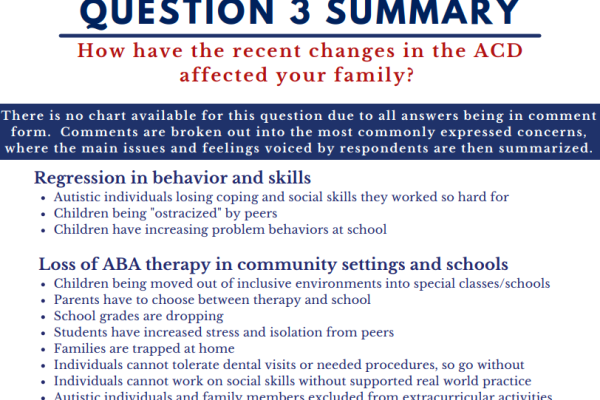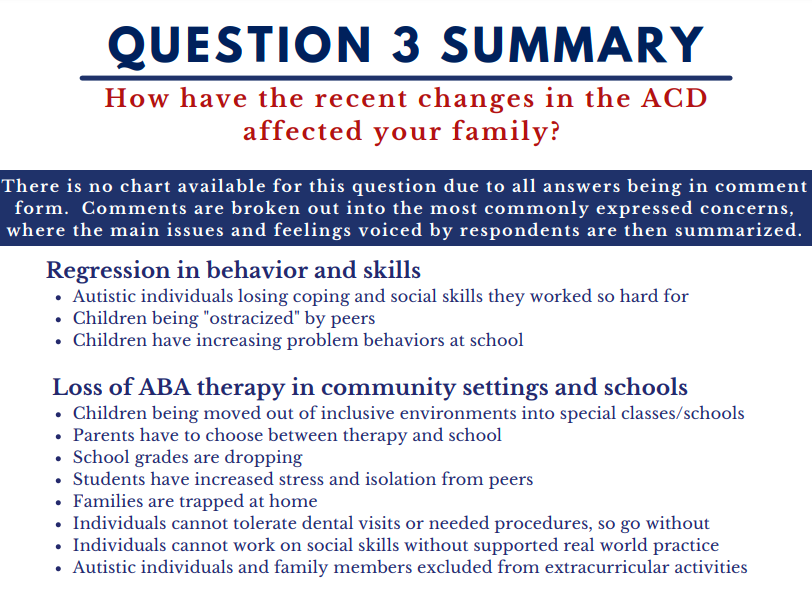
Understanding ABA Therapy
| Autism Spectrum Disorder (ASD), Resources
ABA. Maybe you’ve heard this term dropped before in casual conversation. Perhaps you have talked to a parent at your child’s school who mentioned that their child receives ABA services for an ASD (Autism Spectrum Disorder) diagnosis. Maybe it has been recommended to you that your own child receive this insurance-covered therapy. But what is ABA exactly? Let’s take a look at what ABA therapy is, what it isn’t and five of the most important terms to know about this important type of service.
By Hannah Laney
“What Is ABA?”
ABA stands for “applied behavior analysis.” Sounds complicated? Although it can be pretty complex, applied behavior analysis is simply the science that studies the causes of behavior. It asks the question: Why do we behave the way that we do?
- Why will we watch t.v. instead of hitting the gym to meet our fitness goals?
- Why is that kid in the grocery store throwing a tantrum in the candy aisle?
- Why does my cat wake me up at 3 am every morning?
ABA aims to answer these behavioral questions by observing the patterns that happen before a behavior occurs (known as an antecedent) and what happens after (an outcome or “consequence”).
Although ABA therapy can be used to understand and adjust behavior in anyone, it is most commonly identified as a therapeutic treatment aimed at helping children with Autism Spectrum Disorder (ASD) better manage their behaviors. It is widely accepted in the United States as a medically necessary treatment for children with ASD and is afforded insurance coverage on this basis (see https://www.appliedbehavioranalysisedu.org for a guide to coverage mandates by state). Partners in PROMISE’s resource Partner EFM has monitored TRICARE coverage of ABA (below).

The other important question that ABA asks is “How can we change behavior?” This is where the “applied” part of the science comes in. Professionals that work in the field of ABA therapy focus on identifying causes (i.e. functions of behavior, which we will cover in more detail shortly) and design treatment plans to help create more positive behaviors while decreasing problem behaviors. For example, if your child is struggling with shouting out answers in class after they have been reminded not to, the process of ABA might try to identify ways to increase the behavior of your child raising their hand when they want to speak while decreasing yelling out answers.
Function
No, it’s not that event that you feel obliged to attend even though you’d rather stay home. A function in behavioral terms is the reason a behavior occurs. It’s the why. Discovering this why is an important part of ABA therapy. An assessment of behavior (a functional behavior assessment) is conducted to better understand why a specific behavior is occurring. Generally, there are four potential reasons that a behavior might occur:
- Attention: A child might engage in a behavior to gain attention from adults and/or peers. A good example scenario is when a child displays a problem behavior (e.g. hitting a sibling) because this action will elicit a response from their parent.
- Escape: Have you ever changed your behavior to avoid or run away from a distressing situation? For example, maybe you took a quick turn down a side road to escape that horrendous road work while trying to get to work. Sometimes when the going gets tough, escaping a situation is a powerful motivator for behavior.
- Tangibles: A child might engage in a behavior to (simply put) get something. Remember the example of the child in the grocery store throwing a tantrum? A possible function of that behavior is so they can gain access to something (such as candy).
- Sensory: Perhaps the most confusing category of function is sensory-seeking behavior (also known as automatic reinforcement). This is behavior that fulfills a sensory need. For example, some children with autism enjoy the physical sensations associated with pressure (e.g. from a weighted blanket, vest, gentle squeezing of the arms, etc). This function can sometimes be challenging to identify because it involves internal feelings that a child might not be able to verbally express.
ABA Professionals: The Providers of ABA Therapy
BCBA®
A BCBA® is a Board Certified Behavior Analyst. This is an individual that has met the requirements determined by the BACB (Behavior Analyst Certification Board). A BCBA must at least hold a master’s degree, have complete specific coursework in applied behavior analysis, complete supervision hours and successfully pass an exam demonstrating their knowledge of ABA. All this rigorous education is important because BCBAs are the professionals who evaluate your child’s current behaviors and developmental needs. They design, assess and regularly update a therapeutic treatment plan customized to the behavioral needs they identified. BCBAs are bound to a strict ethical code per their certification with the Behavior Analyst Certification Board. You view the ethical code and verify BCBAs through the BACB’s online certificate base at https://www.bacb.com/.
RBT®
RBT® stands for Registered Behavior Technician. These are the individuals that will be directly working with your child and carrying out the procedures written in the treatment plan designed by the BCBA. The requirements to become an RBT are a high school diploma, 40 hours of training in the principles of ABA, and passing an exam to demonstrate knowledge of ABA principles/procedures. After meeting these requirements, an individual can register with the BACB. It is important to note that RBTs cannot practice without the active supervision of a BCBA. RBTs need to receive a certain amount of supervision each month to ensure that they are properly carrying out the procedures of your child’s treatment plan. As with BCBAs, you can verify the status of an RBT and view the ethical code specific to RBTs at https://www.bacb.com/.
BCABA®
A BCABA® is a Board Certified Assistant Behavior Analyst. This professional must work under the direct supervision of a BCBA; however, the BCBA may delegate supervision of RBTs to a BCABA. A BCABA must have an undergraduate degree, coursework in applied behavior analysis, completion of supervision hours and have successfully passed an exam demonstrating their knowledge of ABA. BCABAs are quickly becoming less prominent in the field, as the bulk of therapeutic services is being shifted towards BCBAs and RBTs.
Tricare Coverage for ABA Therapy
Tricare currently covers ABA therapy for children diagnosed with autism. A formal diagnosis along with a referral is necessary to start the process of obtaining services. Children with autism of active duty service members must be enrolled in EFMP (Exceptional Family Member Program) to ensure that the child’s needs are met with each PCS move. It is important to note that certain geographic locations might have limited ABA services that may significantly impact the quantity and quality of therapy. If your child is currently receiving ABA therapy, it is vital to ensure that your location will support this need. More information on Tricare’s coverage of ABA therapy can be found at https://www.tricare.mil/autism. If you are experiencing difficulties accessing ABA therapy connect with our Resource Partners EFM.
About the Author

Hannah Laney is an Airforce spouse who discovered her love of special education while substitute teaching for her local school district. She holds an M.Ed in Special Education and a graduate certificate in applied behavior analysis from George Mason University. Her previous work as a registered behavior technician contributed to growing her interest in special education advocacy. She is passionate about sharing resources with families about special education services through blogging. In her personal life, she enjoys doing yoga, reading a good book and spending time with her two cats.




I have a 10 year old ASD son, been diagnosed with ASD and receiving ABA for a solid 5 years, and making great progress in school and every other aspect of his life. We’ve figured out how to navigate all the administratively cumbersome new ACD requirements. The only issue is that TRICARE continues to erroneously deny almost all of his ABA claims for randomly incorrect reasons. I have an ACD complaint officer assigned, but the denials keep coming. Referrals are correct, and necessary forms and diagnose tools are all in file. However we keep getting erroneous denials. I’ve engaged my tricare benefits office, they provide updates but nothing that really helps. Is there anything above an ACD complaints officer I can engage with?
Hi Dave,
There are a couple different resources that you can reach out to that might be able to assist you:
– Mission Alpha (missionalphaadvocacy.com): Promotes advocacy and resources related to ABA services provision in the military community.
– Your local EMFP (Exceptional Family Member Program) office
– Militaryonsource.com also has a section related to EMFP service (https://www.militaryonesource.mil/family-relationships/special-needs/exceptional-family-member/).
I have seen firsthand how beneficial ABA therapy can be for children with ASD and the positive impact that it has on the families. I hope that these resources might be able to help you with finding resolution to the challenges you are experiencing with TRICARE coverage.
All the best,
Hannah
It is interesting that ABA therapy is most commonly used to help children with Autism. One of my close friends has a daughter who was recently diagnosed with Autism Spectrum Disorder. I’ll share this article with her so she can find a great center that provides reliable ABA therapy treatment for her kid.
I really enjoyed reading this blog post about ABA therapy. It was helpful to learn about the history and development of this type of therapy, as well as the specific techniques used in treatment. I also appreciated the emphasis on the importance of collaboration between parents and therapists in order to create an effective and personalized therapy plan for each child. Overall, this was a very informative and insightful post on a topic that is often misunderstood.
Your blog provides valuable insights into understanding ABA therapy and its potential benefits and drawbacks. It’s essential to have resources like this to help individuals and families make informed decisions about their loved ones’ care. Thank you for sharing this information.